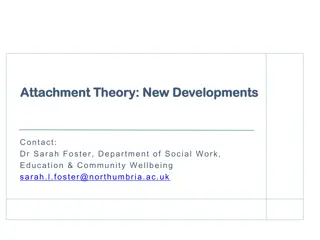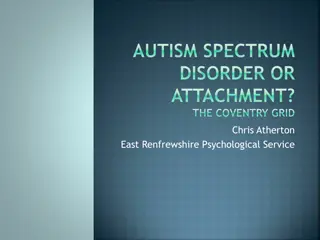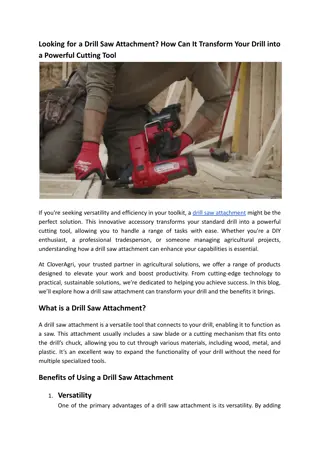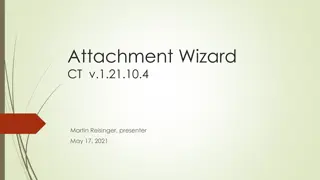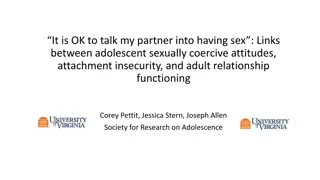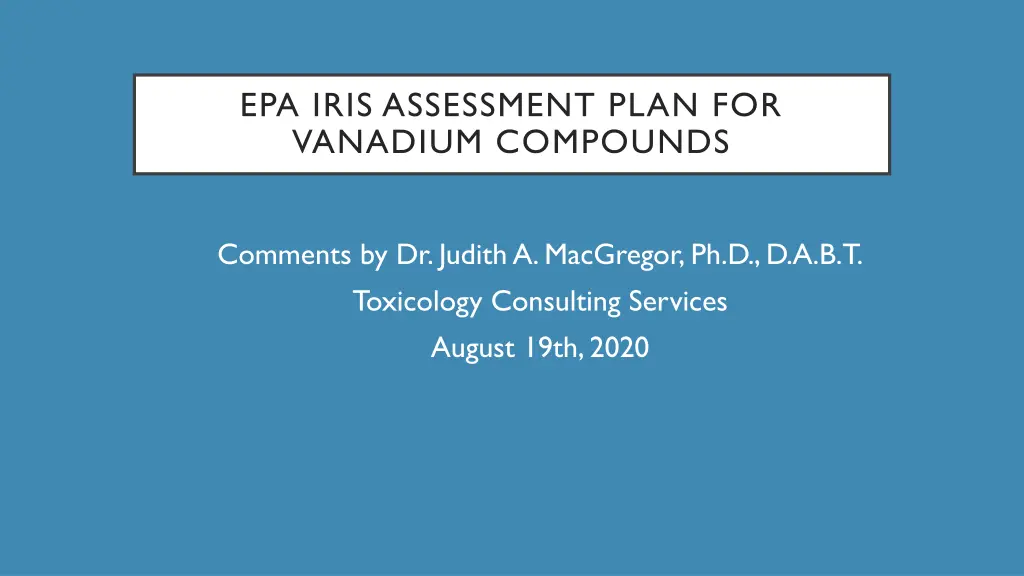
Vanadium Compounds Assessment Plan Comments
Dr. Judith A. MacGregor provides insightful comments on the challenges faced in deriving an RfD for Vanadium Compounds, highlighting study limitations, data extraction process, scoping issues, and key science concerns. The major challenge lies in the limitations of existing studies, necessitating a fresh approach to consider the entire database for deriving an oral reference dose. Study descriptions need clarity for better interpretation and evaluation of toxicity values.
Download Presentation

Please find below an Image/Link to download the presentation.
The content on the website is provided AS IS for your information and personal use only. It may not be sold, licensed, or shared on other websites without obtaining consent from the author. If you encounter any issues during the download, it is possible that the publisher has removed the file from their server.
You are allowed to download the files provided on this website for personal or commercial use, subject to the condition that they are used lawfully. All files are the property of their respective owners.
The content on the website is provided AS IS for your information and personal use only. It may not be sold, licensed, or shared on other websites without obtaining consent from the author.
E N D
Presentation Transcript
EPA IRIS ASSESSMENT PLAN FOR VANADIUM COMPOUNDS Comments by Dr. Judith A. MacGregor, Ph.D., D.A.B.T. Toxicology Consulting Services August 19th, 2020
JUDITH A. MACGREGOR, Ph.D., D.A.B.T. Graduate Training in Toxicology at the U. of Rochester and UC San Francisco Medical Schools, 40+ years of experience Directed a large industrial in-house toxicology laboratory, a contract toxicology testing program, conducted and evaluated chemical risk assessments Familiar with the study designs to assess product safety of chemicals in the US, OECD, and internationally Currently a consulting toxicologist including 15 years studying vanadium compounds, serve as consultant for the domestic(VPRA) and international (Vanitec) trade organizations My comments today are my own and do not represent those of any other organization or company
OVERVIEW OF COMMENTS 1) Challenges For The Derivation of an RfD for Vanadium Compounds 2) Study Quality and the Ramifications for the Data Extraction Process 3) Comments on Scoping Issues 4) Comments on Key Science Issues
MAJOR CHALLENGE: VANADIUM RFD STUDY LIMITATIONS Available studies have significant study limitations compared to the designs for studies typically done for product safety evaluation purposes Test compound often not sourced or analyzed V in water and food not measured, dose uncertain Design and/or methods not standard Very limited endpoints evaluated Poorly reported Records not available Confounders present Inconsistencies across studies Has resulted in divergent approaches to the derivation of an oral reference dose for vanadium compounds and referent values that span 2 orders of magnitude EPA will need a fresh approach, consider the entire database, rely on multiple studies, and the IAP is a good start
STUDY DESCRIPTIONS NEED TO BE CLEAR Ex. Boscolo, 1994 (EPA IAP p5) EPA also developed provisional peer-reviewed toxicity values (PPRTVs) for vanadium and its soluble inorganic compounds other than vanadium pentoxide in 2009, including a chronic provisional RfD (p-RfD) and subchronic p-RfD for vanadium.These values were based on kidney histopathology in a 6-month study by Boscolo et al. (1994), in which rats were given sodium metavanadate in drinking water at levels of 1, 10, or 40 g/mL vanadium; EPA estimated that this corresponded to doses of 0.12,1.2,or 4.7 mg/kg-day based on default drinking water and body weight estimates. however Not a 3 dose study as described but two separate studies 0,10,40 ug/ml 0, 1 ug/ml Kidney histopathology described in a few sentences in the paper, data lacking Concordance of findings with other V studies is poor Ramifications for the Data Extraction Process a Concern
IRIS ASSESSMENT PLAN for VANADIUM COMPOUNDS SCOPING ISSUES: PECO CRITERIA Populations: Seem appropriate as described Exposures: 1) Relevant Forms- Revise focus beyond "inorganic vanadium compounds listed" to include forms that breakdown to inorganic forms. Delete "pharmacologic uses" describe as forms relevant to inorganic vanadium. Address V forms in food. 2) Human- Include systemic effects from worker exposure studies and clinical studies where the exposures are to inorganic forms 3) Animal- Revise focus to include systemic effects from animal inhalation studies where exposures are to inorganic forms
IRIS ASSESSMENT PLAN for VANADIUM COMPOUNDS SCOPING ISSUES- PECO CRITERIA Comparators : Human: Broaden to include- A comparable comparison or referent population exposed or evaluated in the same manner at a similar time. Note, confounders need to be considered. Animal: Seems appropriate as described Outcomes: Seems appropriate as described PK/PBPK: Include biomarkers of exposure, ex blood V or urinary V
A CASE FOR BROADENING THE SCOPE OF THE IRIS RFD LITERATURE ON VANADIUM COMPOUNDS The Value of Inhalation Data: Adds to the database to check for consistency of toxic effects Permits time course evaluation for endpoints of interest Adds a robust data set for systemic pathology Contains studies with larger animal group sizes Longer exposure times including chronic Adds to the comparison of animal and human data Provides a biomarker of exposure to relate to oral studies
A CASE FOR BROADENING THE SCOPE OF THE IRIS RFD LITERATURE ON VANADIUM COMPOUNDS Some of the most robust studies of systemic effects of vanadium compounds are from studies using the inhalation route Ex. NTP #507 2002 A series of V2O5whole body inhalation exposures to rats and mice including 16day, 3mo and 2yr. studies with large group sizes. The target organ was the lung, the site of contact, and not relevant to the RfD, however, a full list of systemic endpoints were assessed including clinical chemistries, hematology, cardiovascular endpoints, full histopathology all tissues all animals. Data tables reported in Appendices. Data Records & tissue specimens in the NTP archives. **Levels of vanadium measured in blood in a satellite study at 5 time points up to 545 days (NTP 2002 appendix K; Dill et al 2004; NTP archive lab report) providing a biomarker of systemic exposure Ex. Kiviluoto et al. 1978-1981 published a series of 7 studies of health effects of vanadium workers, one a study of clinical chemistry parameters
2.5 KEY SCIENCE ISSUES IAP P33 Issue #1 and #2 As Written Both Include Important Elements, but clarify- #1 States bioavailability could be an issue, then concludes separate toxicity evaluations will be done. #2 Not clear if the speciation pertains to what form is administered or exists in vivo or both? Key Issues to consider: Is there a difference in intrinsic systemic toxicity among vanadium compounds or just a difference in absorption and bioavailability? Can the blood vanadium level or other biomarker be a useful predictor of toxicity? Are there effects that occur for intermediate exposures but show accommodation with time? The database contains many limited animal and human studies; is there concordance of effects across studies in animals compared to humans?


